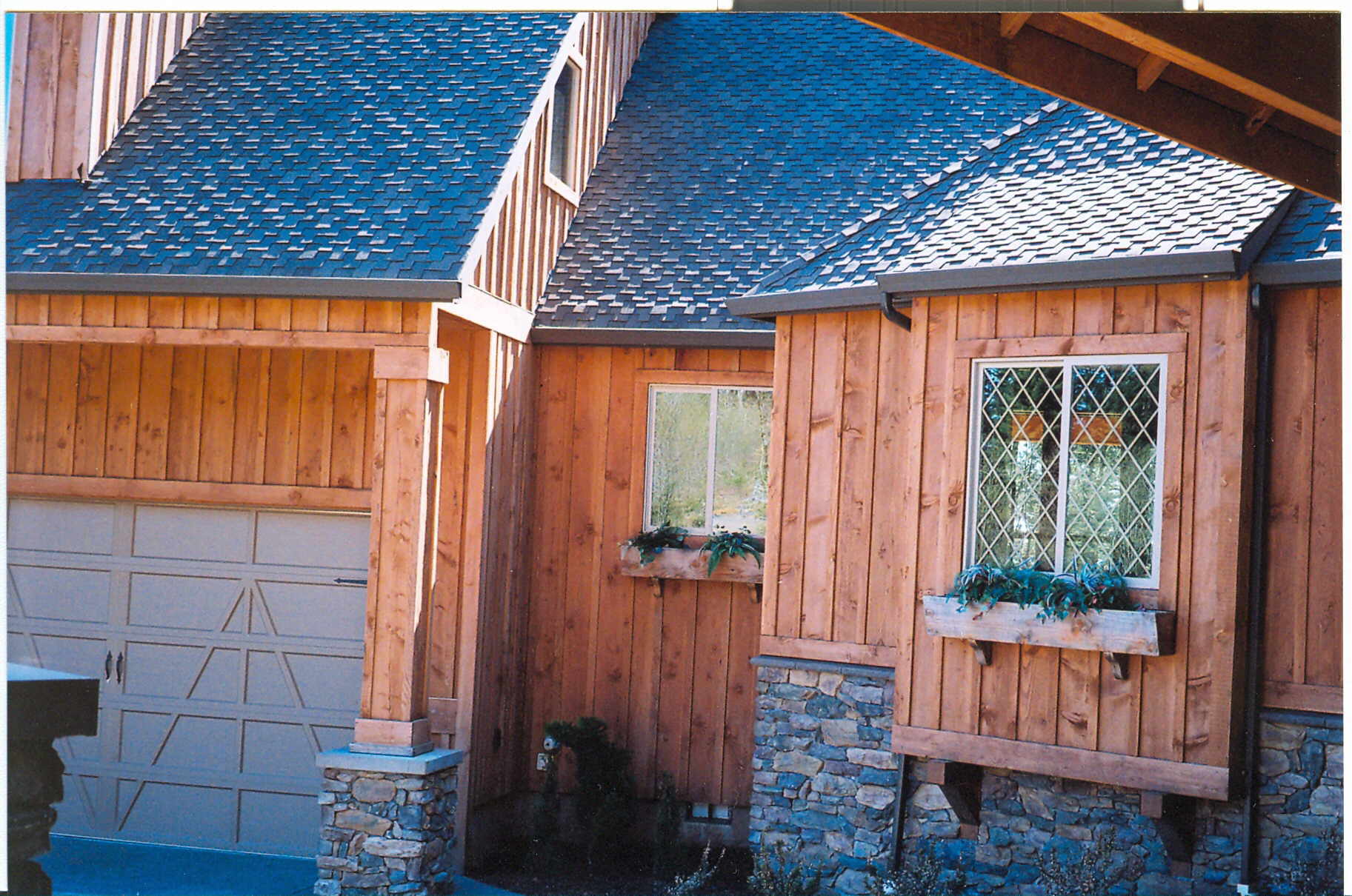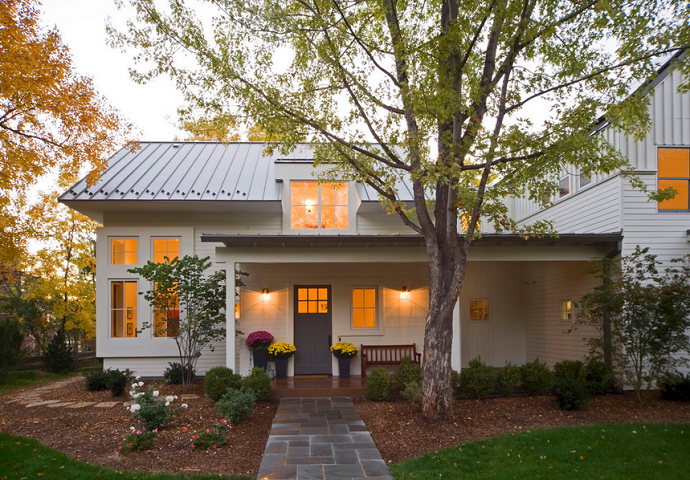Wood siding has many different options. In this buying guide, we’ll focus on styles such as Bevel, Board-and-Batten, and Split Log siding for homes.
 via Real Wood Siding
via Real Wood Siding
Note that there is also a more traditional cedar shingles and shakes siding option explained in our consumer guide here.
The many styles and options of wood siding are what other, competing materials such as Vinyl, Fiber Cement, Engineered Wood and other synthetic materials routinely mimic. Wood though, has a natural beauty that is very hard to match, and yet, with that comes the need for ongoing maintenance.
A few decades ago, wood siding used to be the #1 option for residential siding in America, and historically it has ruled over all others. But not anymore.
According to the U.S. Census data, Stucco and Vinyl are at the top, while wood has declined to just 3% of all new-single family homes having such cladding.
Wood still offers much versatility, decent insulation and installation that doesn’t necessarily require as much expertise as some other siding options.
Cost
The labor costs for installing wood siding, particularly bevel and board-and-batten planks, is comparatively low (compared to fiber cement siding). A handyman can do the job, as can a do-it-yourselfer. Like all home improvement projects, a professional contractor will handle installation more efficiently and provide warranties on their service.
Residential grade (architectural) natural wood siding can cost between $9.50 and $16.50 per square foot, depending on the type of siding being installed, project difficulty, and location. Split log would be on the upper portion of this range, board-and-batten on the lower end, with bevel style siding being somewhere in the middle. Lots of factors impact the costs for wood siding which we’ll address below.
A typical two-bedroom house requiring 2,000 square feet of siding will cost between $19,000 and $33,000 for new natural wood siding installed by a professional contractor. That’s for all 3 materials included, which is why the range is so great. If we break down the prices by type of style, it helps understand project costs more acutely.
Cost Info – Part 2
Our guide is to help you understand information you’d likely come across on an estimate for a wood siding project from a contractor. We’ll split it into three hypothetical projects based on the primary styles, along with additional considerations that usually come up with a residential siding project. Please note these are ballpark estimates based on the national average information.
Project example 1: Wood Cedar Bevel Siding
Wood Cedar Bevel Siding: 2,000 sq. ft. x $12.50 = $25,000 (includes labor)
House Wrap: $400
Additional Building Materials: (i.e. corner boards, siding nails, trim board) = $600
Building Permit: $400
Total Project 1 Cost = $26,400
Project example 2: White Pine Board-and-Batten Siding
White Pine Board-and-Batten Siding: 2,000 sq.ft. x $10.50 = $21,000 (includes labor)
Removal of previous siding: $2,000
Garbage Rental / Disposal Charge: $1,000
House Wrap: $400
Additional Building Materials: (i.e. caulk, galvanized nails, Z-flashing) = $700
Building Permit: $400
Total Project 2 Cost = $25,500
Project example 3: Cedar Half Log Wood Siding
Cedar Half Log Wood Siding: 2,000 sq.ft. x $13.50 = $27,000 (includes labor)
House Wrap: $400
Additional Building Materials 1: (i.e. caulk, galvanized nails, Z-flashing) = $750
Additional Building Materials 2: (semi-transparent stain) = $4,250 (includes application labor)
Building Permit: $400
Total Project 3 Cost = $32,800
We’ve included a few additional items that, as you can see, increase the costs. In our next section, we’ll overview the various factors that are likely to come up with wood siding options.
Factors Impacting Overall Costs
The first consideration usually deals with removal of old siding. Then once removed, it obviously needs to be disposed of. While this adds a few thousand to overall cost, a professional contractor can usually have a crew take care of this in a day and clean up your yard plus dispose of the material.
The style of wood is the next factor to consider. This along with type of wood and quality are all factors that will impact cost. Pine, oak, cedar, and redwood are popular wood grains used for residential siding.
A contractor is likely to recommend the type of wood depending on the style, but also able to select whatever grain and quality you are willing to pay for. Wood quality deals with whether the surface has blemishes or knots. Clear grades are considered premium quality, while some homeowners prefer the more authentic look of knotted wood.
Sub-options within styles come up in bevel and split logs where you can select among many considerations in how the planks, or logs, are cut. With split log there may be the option to chink the material.
In contemporary siding jobs, this is purely stylistic, but mimics how log cabin homes used to be built where the mortar was visible between each log. Usually, an acrylic compound is used. This adds a wee bit more protection from water and wind to the building envelope, but does cost more both during installation and then for the ongoing maintenance.
Board-and-batten is rather simplistic, but that’s generally a good thing. This style has a craftsman appeal to it and can look fantastic with a standing seam roof.
The building materials and a building permit aren’t optional and ought to be considered part of the overall costs necessary to complete the job. Sometimes, contractors will include these figures in the “siding cost” and not separate them out as unique line items.
If a stain or coat of paint is desired, the contractor doing the siding job may do this or even offer to do it, as is likely the case with split log. This can be rather expensive, but certainly offers a layer of protection to the wood and helps maintain the wood over the long term.
Initially, coatings can last 15 years, maybe longer. After that, re-coating every 7 to 12 years will help get the most out of your wood siding to last up to 50 years.
The labor charge is the last significant factor. With wood siding, prices are generally low and competitive as it is understood wood siding is the type of job that you can go with DIY or hire a non-certified worker to do the work.
We may be biased, but we’d suggest you at least consider getting three to seven quotes from local contractors and what their work offers to you before you entertain going with a less experienced installer.
The Good, The Bad and The Oh So Pretty
Here we list the pros, cons, and the chief reason to consider wood siding.
The Good: Wood siding offers a fairly durable cladding material for residential structures. Especially if properly maintained. The R-Value is very good compared to many of wood’s competitors, which translates to better insulation for the envelop of your home. And because wood is easier to install than most, if not all, other materials, its costs can be kept down.
The Bad: The well-known disadvantage of wood is its requirement for ongoing maintenance. Without such upkeep, wood may last 30 years or less before the weather wears it down, or worse, animals start to eat away at the material. Better quality wood is an advantage, but also does increase costs. Plus, wood is highly flammable, though it may be treated with fire retardants to minimize what would otherwise be kindling.
The Oh So Pretty: Beauty is what makes wood a viable choice. Other materials can come close to the look of wood, but none match it exactly, not even engineered wood. With a fresh coat of clear stain, wood siding is a work of art, or craftsmanship.
Is Natural Wood Siding a Viable Option for your Home?
Yes, natural wood siding can be a viable option for homes. It offers several benefits, including its natural beauty and the fact that wood is a renewable resource. However, there are some factors to consider when deciding whether wood siding is right for your home.
Firstly, wood siding requires regular maintenance to protect against weather damage, pests, and rot. This includes periodic cleaning, staining or painting, and potential repairs or replacements of damaged boards.
Secondly, wood siding can be more expensive than other siding materials, such as vinyl or fiber cement. However, the cost can vary depending on the type of wood used, the size of the home, and other factors.
Lastly, wood siding may not be suitable for homes in areas with high humidity, heavy rainfall, or extreme weather conditions. In such cases, other materials like vinyl, fiber cement, or metal may be more appropriate.
Pro Tip: Use decay-resistant wood such as redwood, cedar, or cypress in high humidity and moisture climates.
Overall, natural wood siding can be a good option for homes, as long as the homeowner is willing to invest in its maintenance and upkeep over time.
FAQs
- What types of wood are commonly used for siding? Common species of wood used for siding include cedar, redwood, cypress, and pine. Each species has unique characteristics, such as color, texture, and durability.
- How long does natural wood siding typically last? The lifespan of natural wood siding can vary depending on factors such as the type of wood used, the climate, and the amount of maintenance it receives. With proper care and maintenance, natural wood siding can last for several decades.
- How does natural wood siding compare to other siding materials? Natural wood siding offers unique beauty and warmth that other materials may not be able to replicate. However, it requires more maintenance than materials like vinyl or fiber cement, and may be more vulnerable to weather damage and pests.
- What kind of maintenance does natural wood siding require? Natural wood siding requires periodic cleaning, staining or painting, and repairs or replacements of damaged boards. Neglecting maintenance can lead to weather damage, rot, and pests.
- Is natural wood siding environmentally friendly? Wood is a renewable resource, and using natural wood siding can be a sustainable choice for homeowners who are conscious of their environmental impact. However, harvesting and processing wood can have negative environmental impacts if not done responsibly.
- How does natural wood siding affect the value of a home? Natural wood siding can increase the value of a home if it is well-maintained and complements the overall design and style of the home. However, if the siding is neglected or does not match the rest of the home, it may detract from the home’s value.
- Can natural wood siding be painted? Yes, natural wood siding can be painted or stained to achieve a desired look or color. However, it is important to choose a paint or stain that is designed for use on wood siding and to follow proper application techniques.
- How does natural wood siding hold up in extreme weather conditions? Natural wood siding can be more vulnerable to weather damage in extreme conditions such as hurricanes, heavy rainfall, or high winds. Homeowners in areas prone to extreme weather may want to consider other siding materials, such as fiber cement or metal.
